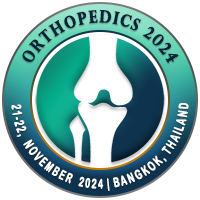
Mosheer Ziadi
Orthopedic Consultant, KAMC, Saudi ArabiaTitle : Dead Or Alive ? Use Of Indocyanine Green Fluorescence For Assessing Vitality In Non-Union Fractures
Abstract
Aim: Our purpose was to introduce the use of ICG fluorescence angiography to evaluate the blood flow of bone in patients with atrophic non-union
Background: In the treatment of non-union fractures, surgeons often manage non-vital tissues. Bone perfusion is surgically assessed based on the surgeon’s experience and paprika sign. However, big bone defects are missed due to the surgeon’s inability to determine the amount of affected bone that needs to be removed. Intraoperative estimation of bone microcirculation in traumatology using indocyanine green (ICG) fluorescence may serve as a valuable and safe procedure that may aid in decision making Technique: We preliminary used this technique in our institute from April 2019 to June 2021 on twelve patients treated for tibial shaft non-union. We used Stryker System for ICG fluorescence imaging. After non-union site debridement, the tourniquet was deflated, and 0.5 mg/kg of ICG powder dissolved in sterile saline at 2.5 mg/ml concentration was administered. The time from injection and the beginning of appreciation of the green area was measured. Non-viable bone was resected accordingly
Conclusion: ICG fluorescence angiography allowed a rapid visualization of blood flow in the bones after 25–45 s. In all patients, tissue resection was less than what planned preoperatively and what observed intraoperatively. No intraoperative or post-operative adverse events were observed. After ICG injection, the oxygen level was reduced due to a bias in pulse oximeter reading. This phenomenon was not clinically relevant Clinical Significance: ICG fluorescence imaging surgical applications continue to evolve. This procedure is promising in the treatment of non-union defects because it is safe, easy, and rapid and contribute to intraoperative decision making for establishing resection levels. Using ICG fluorescence could demonstrate bone perfusion to help surgeons to reduce bone resection and avoid massive bone defects
Biography
Mosheer Ziadi is an orthopedic surgeon, had his initial training in Saudi Arabia and further training in Milan, Italy . He underwent training for General Orthopedic Surgery and Trauma in King Faisal Specialist Hospital and did his limb reconstruction fellowship in Italy. Since the completion of his training, he has continued to hone his skills through practising in both the public and private health sectors.

